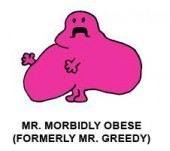 |
| The AUC for all three "curves" = 4. |
a) "X" grams of a high-Glycaemic Index (GI) carb e.g. glucose, maltodextrin or amylopectin result in a large glucose response that goes away rapidly, as the carbs leave the gut rapidly, pass into the blood rapidly and are cleared from the blood rapidly due to the large insulin response.
b) "X" grams of a 50:50 mixture of high & low-GI carbs result in a lower but longer sustained glucose & insulin response, as some carbs leave the gut rapidly but some carbs leave the gut slowly, pass into the blood slowly and are cleared from the blood slowly due to the small insulin response.
c) "X" grams of a low-GI carb e.g. amylose or resistant starch result in an even lower glucose & insulin response that is sustained for even longer, as the carbs leave the gut very slowly, pass into the blood very slowly and are cleared from the blood very slowly due to the very small insulin response.
Will a), b) & c) produce the same satiety? I think not. I think that a) results in lower satiation than b) and b) results in lower satiation than c). Whether returning hunger is caused by a sudden drop in blood insulin level or by a sudden drop in the amount of food in the gut, I don't know.
The reason for this post is A satiety index of common foods (scanned image of full study here) and the related study An insulin index of foods: the insulin demand generated by 1000-kJ portions of common foods.
In the first study, boiled potatoes produced the highest satiety, yet in the second study, boiled potatoes produced one of the highest glucose & insulin AUCs. How can this be? Consider the preparation method for the Russet potatoes:-
"Peeled, boiled for 20 min, and stored at 4 °C overnight; reheated in a microwave oven for 2 min immediately before serving."
Potato starch when refrigerated produces resistant starch RS3, which gives it a low GI (see item 605 in International table of glycemic index and glycemic load values: 2002). Therefore, refrigerated potatoes contain a mixture of high & low-GI starches. This, I believe, is why boiled, refrigerated & reheated potatoes produced the highest satiety. The combination of water, fibre & resistant starch kept hunger pangs away the longest. I suspect that boiled potatoes that are eaten without being refrigerated won't produce quite as much satiation, as they contain no resistant starch.
EDIT: From https://en.wikipedia.org/wiki/Resistant_starch#Definition_and_categorization :-
"RS3 Resistant starch that is formed when starch-containing foods are cooked and cooled, such as pasta. Occurs due to retrogradation, which refers to the collective processes of dissolved starch becoming less soluble after being heated and dissolved in water and then cooled."
RS3 forms a gel in the stomach, which delays stomach emptying. This is most likely the reason for the increased satiation.

































